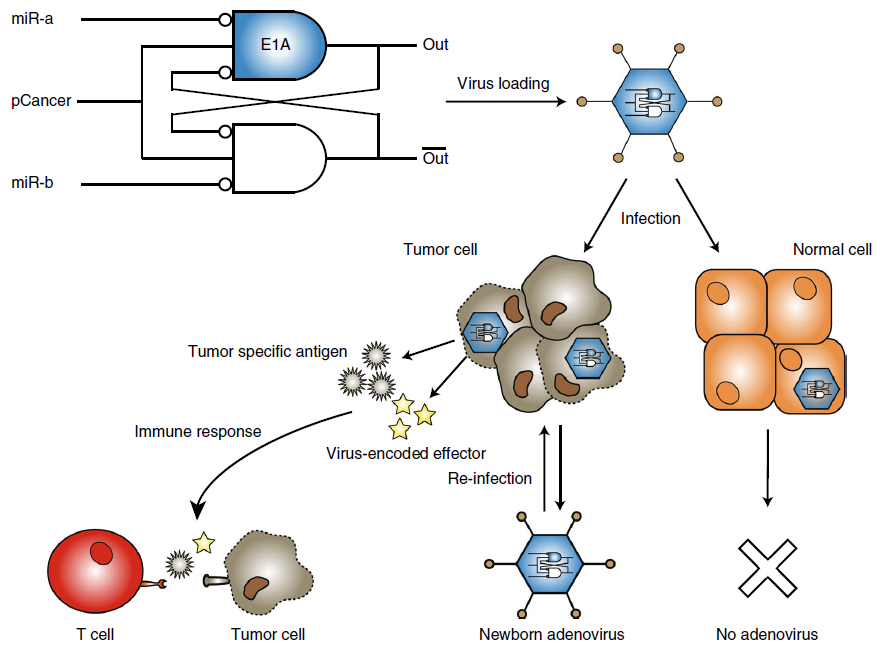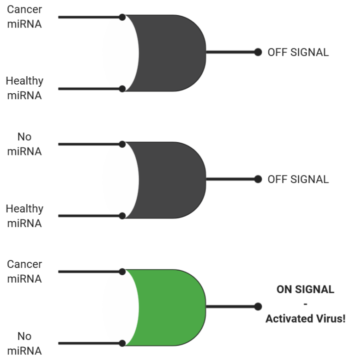News
Programmed to kill: Synthetic virology to attack cancer
Author: Alexander Baker, 26th November 2019
Carefully modified viruses are becoming major new drugs in the battle against cancer. The idea is that the viruses can be re-engineered so instead of attacking healthy cells and causing disease, they only attack cancer cell. Unlike normal drugs which are slowly depleted, the viruses can create copies of themselves which can spread in the body and kill more cancer.
These cancer killing viruses, or oncolytic virotherapies, have already seen success. T-VEC (a heavily modified version of Herpes virus) was approved to treat skin cancer by the American food and drug administration (FDA) and European medical associations (EMA) in 2015 and dozens more virotherapies are on the way. However, despite T-VEC’s success challenges remain in developing virotherapies potent enough to treat the most difficult of cancer types. This include making sure the virotherapy can only attack the cancer and making sure that once it does attack the cancer it can kill it.
Scientists at Tsinghua University in Beijing have found a novel way to make the virotherapy deadly in cancer cells, but harmless to healthy ones (Huang et al. 2019). For this they turned to another branch of science which was, until recently, science fiction: Synthetic Biology. Synthetic biology (sometimes called SynBio) is a new area of biology which treats cells like computers, with DNA being the computer program which controls them. Usually synthetic biology is used in industrial applications, such as to produce chemicals for perfumes and food flavourings, so this is one of the first times it has been used in healthcare.

The researchers chose to focus on hepatobiliary carcinoma (HCC), a rare but especially deadly cancer of the liver and bile ducts. They first identified some factors which make the cancer different from the surrounding healthy cells, discovering specific micro RNA’s (miRNA) were present in the HCC cancer cells and not the healthy cells. They also found some miRNAs which are only present in the healthy cells. They then designed a genetic circuit to control the replication of an oncolytic virus.
 The researchers made a new version of the oncolytic viruses genome in which its ability to made copies of itself and destroy the cells it infects is dependent upon the circuit. The first infects the cells. If they are healthy the miRNA switches off the virus, leaving it harmless. If it’s a cancer cell it switches on, replicating and destroying the cell it has infected. But to be double safe the researchers programmed their virus so that the infected cell had to both have the cancer miRNA and NOT have the healthy miRNA.
The researchers made a new version of the oncolytic viruses genome in which its ability to made copies of itself and destroy the cells it infects is dependent upon the circuit. The first infects the cells. If they are healthy the miRNA switches off the virus, leaving it harmless. If it’s a cancer cell it switches on, replicating and destroying the cell it has infected. But to be double safe the researchers programmed their virus so that the infected cell had to both have the cancer miRNA and NOT have the healthy miRNA.
But the researchers didn’t stop there. In order to make sure their programmed oncolytic virotherapy could kill the cancer they added an immunotherapy called anti-PD-1 ScFv. These are protein molecules which signal to the body that the cells they are in should be destroyed.
This creates a trinity of cutting-edge science. An oncolytic virotherapy to seek out and infect cancer cells, a synthetic biology to program the virus to only destroy cancer, and an immunotherapy to teach the body to destroy the cancer cells. When a mouse model of liver cancer was treated with this programmed and immunotherapy armed oncolytic virus 100% of them survived after 50 days. Untreated these mice only survive to approximately 38 days.
While this therapy is a long way from being used in humans yet it is a critical proof on concept. Proving that it is possible not just to use a virus to treat cancer, but that it is possible to program this virus like a computer to be safe in healthy cells and deadly to cancer. This study showed promise in HCC, but the same concept can, theoretically, be applied to any cancer. Hopefully this work will help mature the oncolytic virus field and lead to powerful new treatments for other difficult cancers.
References
Huang, H., et al. (2019). “Oncolytic adenovirus programmed by synthetic gene circuit for cancer immunotherapy.” Nat Commun 10(1): 4801.